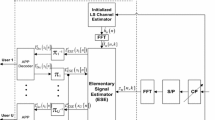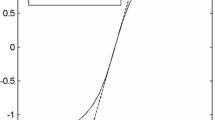Abstract
Transmit power control is indispensable in Direct Sequence Code Division Multiple Access (DS/CDMA) based systems such as the Satellite Universal Mobile Telecommunication System (S-UMTS). Since S-UMTS aims at achieving close integration with the terrestrial component (T-UMTS) in its complementary role, it is going to implement closed-loop transmit power control (TPC) at a slow rate of once every frame. In addition, predictive schemes can be used to mitigate the effects of delay. In this regard, recursive-least-squares (RLS) and least-mean-square (LMS) algorithms are normally employed. The RLS algorithm has a higher convergence rate than the LMS algorithm: an attractive attribute when the fading process abruptly changes. The LMS algorithm, on the other hand, has better tracking property than the RLS algorithm: an attractive attribute when the changes in the fading process are persistently slow. However, the mobile satellite system channel exhibits both attributes: abrupt changes and slow drifts. In this paper, therefore, we compare the performance of predictive TPC based on the RLS and the LMS algorithms for S-UMTS with the conventional TPC as a reference. We demonstrate that the predictive TPC schemes perform better than the conventional TPC scheme. However, the performance gain achieved depends on the predictive algorithm used, the environment in which the user equipment is operating, and loop delays. We show that, in general, the LMS based predictive TPC offers better performance than the RLS based predictive TPC scheme in S-UMTS environment.
Similar content being viewed by others
References
F. Ananasso and F.D. Priscoli, The Role of Satellite in Personal Communication Services, IEEE Journal on Selected Areas in Communications 13(2) (Feb. 1995) 180–196.
N.J. Bershad and O.M. Macchi, Adaptive Recovery of a Chirped Sinusoid in Noise, Part 2: Performance of the LMS algorithm, IEEE Transactions on Signal Processing 39(3) (March 1991) 595–602.
D. Boudreau, G. Caire, G.E. Corazza, R. De Gaudenzi, G. Gallinaro, M. Luglio, R. Lyons, J. Romero–Garcia, A. Vurnucci and H. Widmer, Wide–band CDMA for the UMTS/IMT–2000 satellite component, IEEE Transactions on Vehicular Technology 51(2) (March 2002) 306–331.
A. Chockalingam, P. Dietrich, L.B. Milstein and R.R. Rao, Performance of Closed-Loop Power Control in DS-CDMA cellular systems, IEEE Transactions on Vehicular Technology 47(3) (August 1998) 774–789.
R. De Gaudenzi, C. Carlo and R. Viola, Bandlimited Quasi–Synchronous CDMA: A Novel Satellite Access Technique for Mobile and Personal Communication Systems, IEEE Journal on Selected Areas in Communications 10(2) (Feb. 1992) 328–343.
B.G. Evans, M. Mazzella, G.E. Corazza, A. Polydoros, I. Mertzanis, P. Philippopoulos and W. De Win, Service Scenarios and System Architecture for Satellite UMTS IP Based Network (SATIN), in AIAA 20th International Communications Satellite Systems Conference 2002 Montreal, Canada (May 2002).
E. Eweda, Comparison of RLS, LMS and sign algorithms for tracking randomly time–varying channels, IEEE Transactions on Signal Processing 42(11) (Nov. 1994) 2937–2944.
H.S.H. Gombachika, B.G. Evans and R. Tafazolli, Predictive power control for S-UMTS Based on Least Mean Square Algorithm, in: The Proceedings of the third IEE International Conference on 3G Mobile Communication Technologies, London, UK (May 2002) pp. 128–132.
S. Haykin, Adaptive Filter Theory (3rd ed) (Prentice-Hall International, London third, 1996).
S. Haykin, A.H. Sayed, J. Zeidler, P. Yee and P. Wei, Adaptive tracking of linear time–variant systems by extended RLS algorithms, IEEE Transactions on Signal Processing 45(5) (May 1999) 1118–1128.
A.M. Law and W.D. Kelton, Simulation Modeling and Analysis. (3rd ed) (McGraw-Hill, New York, 2000).
W.C.Y. Lee, Overview of cellular CDMA, IEEE Transactions on Vehicular Technology 40(2) (May 1991) 291–302.
O.M. Macchi and N.J. Bershad, Adaptive Recovery of a Chirped Sinusoid in Noise, Part 1: Performance of the RLS algorithm, IEEE Transactions on Signal Processing 39(3) (March 1991) 583–594.
M. Mehta, D. Nunn and S. Braithwaite, Predictive Action Power Control Scheme for a Mobile Satellite System, in: The Proceedings of IEEE International Conference on Universal Personal Communications(ICUPC) (Massachusetts, USA, Sept. 1996).
A.M. Monk and L.B. Milstein, Open-loop Power Control Error in Land mobile Satellite system, IEEE Journal on Selected Areas in Communications 13(2) (Feb. 1995) 205–212.
A. Ogawa, M. Katayama, T. Yamazato and A. Jamalipour, CDMA for Personal Communications Based on Low Earth Orbital Satellite Systems, IEICE Transactions on Fundamentals E80–A(12) (Dec. 1997) 2347–2355.
A. Papoulis, Probability, Random Variables, and Stochastic Process (3rd ed.) (McGraw-Hill, New York, 1991).
J.G. Proakis and D.G. Manolakis, Introduction to Digital Signal Processing (London: Macmillan, 1988).
A.H. Sayed and T. Kailath, A State–Space Approach to Adaptive RLS filtering, IEEE Signal Processing Magazine 11(3) (July 1994) 18–60.
M.L. Sim, E. Gunawan, B.H. Soong and C.B. Soh, Performance Study of Closed-loop Power Control Algorithms for a Cellular CDMA system, IEEE Transactions on Vehicular Technology 48(3) (May 1999) 911–921.
P. Taaghol, B.G. Evans, E. Buracchini, R. De Gaudenzi, G. Gallinaro, J.H. Lee and C.G. Kang, Satellite UMTS/IMT2000 W–CDMA air interfaces, IEEE Communications Magazine 37(9) (Sept. 1999) 116–126.
A.J. Viterbi, CDMA: Principles of Spread Spectrum Communication. (Reading: Addison-Wesley, 1995).
Author information
Authors and Affiliations
Corresponding author
Additional information
Harry S. H. Gombachika is currently a Senior Lecturer in Telecommunications at the University of Malawi. He received a B.Sc. in Electrical Engineering from the University of Malawi in 1990, an M.Sc. in Electrical Engineering from the State University of New York at Buffalo, USA in 1996, and a Ph.D. in Electrical Engineering from the University of Surrey, UK in 2003. He joined the University of Malawi in 1990 as a staff associate and has since worked as an assistant Lecturer and Lecturer. From 1998 to 2000 he worked as the head of the Electrical Engineering department. His research interests include telecommunication networks for rural areas and capacity enhancing techniques for mobile communication systems.
Rahim Tafazolli is the Head of Mobile Communications Research Group in CCSR, School of Electronics and Physical Sciences. His research activities are on optimization techniques for mobile multimedia networks, mainly on advance Resource management, Mobility management and Media Access Control. He has published more than 300 research papers in refereed journals, international conferences and as invited speaker. He currently has more than 15 patents in the field of mobile communications. He is advisor and consultant to a number of mobile companies and external examiner to Birmingham University (UK), and Nanyang University (Singapore). He is the founder and the past Chairman of International Conference on “3G Mobile Technologies”. He is also member of IEE Committee on the UK Regulations on “Information Technology & Telecommunications”, a member of the EU Wireless Strategy Initiative (WSI) Think-Tank group, Chairman of “New Technologies” group of Wireless World Research Forum (WWRF), and academic co-ordinator of the UK Mobile VCE (Virtual Centre of Excellence).
Barry Evans was educated at the University of Leeds, obtaining BSc (1st Class Hons.) and Ph.D. degrees in 1965/8 respectively. He then joined the British Telecom sponsored team at the University of Essex (Lecturer-Reader 1968-83) where he was responsible for Telecommunications Systems post-graduate activities and radio and satellite research. In 1983 he was appointed to the Alex Harley Reeves Chair of Information Systems Engineering at the University of Surrey. In 1990 the research was brigaded into a new research centre at Surrey (the model for future developments at Surrey)—the Centre for Satellite Engineering Research. In 1996, he became Director of the new Centre for Communication Systems Research (CCSR) within the School of Electronics & Physical Sciences. From 1998 Barry was Dean of Engineering at Surrey overseeing the restructuring of engineering on the Surrey campus. From August 2001 he was appointed Pro-Vice-Chancellor for Research and Enterprise. Barry Evans was instrumental in setting-up, within Foresight, the idea of Virtual Centres of Excellence. He has served on the MOD DSAC Committee for the ten years, which involves advising MOD on its research programmes. He was also the U.K. delegate on the COST 252, 253 and 272 Committees as well as a delegate to several ETSI Committees. He is editor of the International Journal of Satellite Communications and the author of three books on telecommunications and satellites as well as over 400 papers in learned journals. He was elected to a Fellowship of the Royal Academy of Engineering in 1991.
Rights and permissions
About this article
Cite this article
Gombachika, H.S.H., Tafazolli, R. & Evans, B.G. A Comparative Study of Predictive Transmit Power Control Schemes for S-UMTS. Wireless Netw 11, 215–222 (2005). https://doi.org/10.1007/s11276-005-6605-8
Issue Date:
DOI: https://doi.org/10.1007/s11276-005-6605-8




